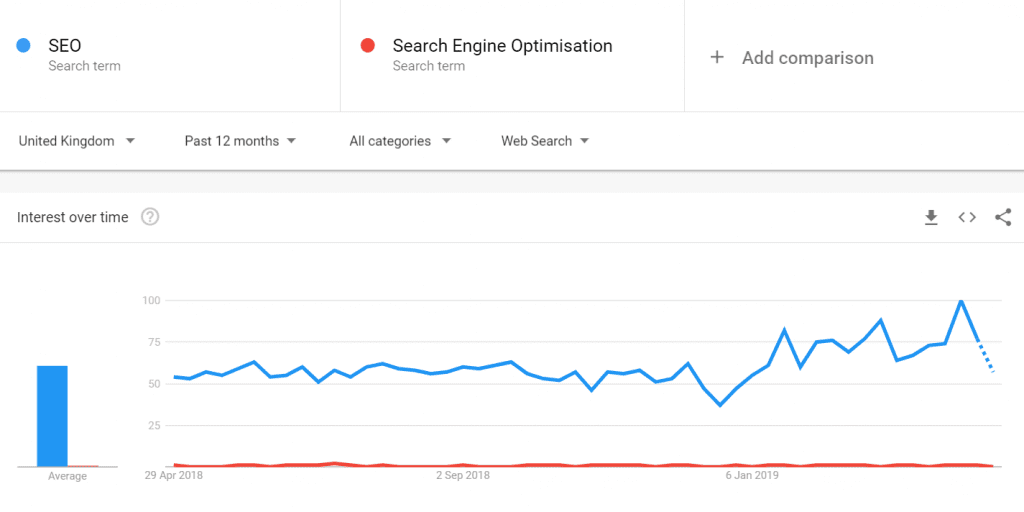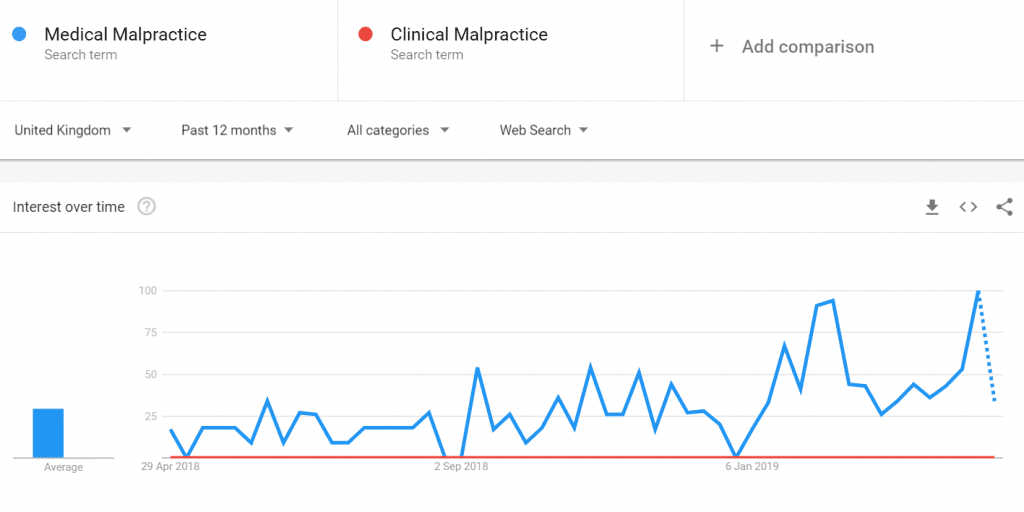When you’ve been in enough meetings about SEO, the phrases ‘keywords’ and ‘search volume’ start to lose their significance – they’re just another part of the job, another datapoint digital marketers use to deliver the best results we can.
However, it’s important to remember that SEO is just a tactic – certainly an important one, but not the be all and end all. When we take a step back and think about the wider strategic context, these SEO buzzwords take on a different light.
What are ‘keywords’?
Before we go any further, let’s go back to basics and talk about what keywords really are.
A keyword is a search term that has been identified as significant and relevant to a specific piece of content around either a question relating to your offering, or to a particular product or service.
But where do these keywords come from? In terms of how digital marketers get to them, we use a variety of tools – perhaps the most common of these being the Google Ads Keyword Planner. This allows us to see how many searches a particular term is getting per month, and also find related search terms that are similar or otherwise relevant to the topic or audience.
Now this is all pretty basic stuff, but within it lies an important concept to get your head around. Yes, keywords and their associated search volumes are datapoints – but those datapoints don’t come out of thin air.
A keyword and its associated search volume is very literally what a user has typed (or potentially spoken) into a search engine and how often that has occurred over a defined period of time (e.g. you will likely think in terms of number of searches per month).
A window into the mind of users
Why does this matter? Well, the first thing to realise is that, more often than not, people don’t change their language when they search.
When I’m looking for goods or services, I won’t pause to consider the terms I’m going to use – I’ll use what first comes into my mind. Essentially, I will use whatever feels most natural. This is likely to become even more significant as the frequency of voice search continues to grow.
The point here is that what I search for is a reflection of what I think. Or to spin it the other way, the way I think about products and services will be directly reflected in the way I search.

This is why something that gets thrown around in the SEO world that seems basic can actually be incredibly powerful when it comes to formulating your digital marketing strategy and helping you make better decisions in a wider business context.
Informing your digital marketing strategy
Beyond simply telling you which terms you should be optimising for in your website copy or which terms you should be targeting with your PPC campaigns, keywords can help to shape and inform strands of activity across your digital marketing strategy.
Justifying resource (and budget) for digital asset production
There is always an amount of effort – and therefore resource and cost – attached to the production of the kinds of high-quality digital assets that are going to give you an edge. Whether it’s a whitepaper, an infographic, a video, or new functionality (such as a tool or wizard of some kind) for your website, these things don’t happen for free.
Search volumes can give you a way to scope out the level of interest in a particular asset before you even begin working on it, adding another layer to your pitch for time or money.
For example, if I were looking to justify the need for copywriting, design and promotion of a content strategy guide, I might use the following search volumes to identify interest:
- Content marketing guide (70 searches per month)
- Content creation guide (30 searches per month)
- How to create a content strategy (30 searches per month)
Already, I’ve got 130 searches per month from users specifically looking for the asset I’m looking to produce – and that’s only three keywords. I could continue to add keywords like content strategy template pdf, digital content strategy best practice guide, and content marketing pdf to add another 50 searches per month to the pot.
I’m not just building a picture of the level of specific interest in what I’m creating, I’m also starting to learn what that asset might need to be – in this case a PDF – and also some of the topics that I should look to cover. In this scenario, both strategy and production, as well as some kind of template, seem like points that need to be hit.
At this point, I’m already significantly ahead of where I was when I started, which was the initial thought of ‘maybe I should pitch for some resource to create an asset around content marketing’. I now know what kind of asset to create, what it should be about, and how many people are searching for it per month. What’s more, I already have some pretty good ideas about what the asset should be called.
Prioritising which products or services to promote with paid media
When it comes to working out where to put your marketing budget, there’s often a decision to be made about which of your products or services to put your budget behind – for example, which service is going to be the focus of your programmatic display activity in the next 3 months?
Looking at the search volumes around those products or services – both at a brand and generic level – can help to inform that decision.
Here are some examples of how search volumes can help you make decisions about your wider digital paid media strategy.
Example 1
You might see, having looked at the search volumes around your products and services, that your marquee or priority product has the benefit of the highest search volumes. As that’s the business priority you can push budget into the wider promotion of that product. You can push social media or display for example, in the knowledge that there is already consideration for that product through search.
The idea here is that by showing that message to prospects that are already considering your product, you will increase the likelihood that they go on to convert.
Example 2
You might see that your highest margin product – or perhaps the service on which you have the highest close rate, or highest retention rate – is the one with the lowest search volume. Here you have an issue, there’s a gap between where you have the most to gain and the level of interest being displayed by your audience.
Therefore, you can embark on a different kind of paid media campaign. Rather than looking to convert existing awareness and consideration into a conversion, we can look to build that initial awareness and then drive those users into the consideration stage.
We know there’s value to be had here, because the product we’re driving these users towards has a significant margin or some other advantage for us as a business. Over time, all things being done correctly, we might even see the aforementioned search volumes start to increase as we push more users to consider that product.
Informing decisions in the wider business
While it could be seen as obvious that keywords can help us make better decisions about what we do in the digital space, what’s perhaps more interesting is how search volumes can help you make bigger decisions across your business.
Knowing what to call what you do
The reason I think it’s so important to understand where keywords come from is that’s its so often misunderstood how valuable that insight is.
One thing that’s understood beyond the digital sphere is that consumers – whether those are people looking to make a single purchase in the B2C sphere or organisations looking to take on a service provider in the B2B sphere – are far easier to convince and convert when you’re speaking the same language.
Time and time again we’ve seen examples where internal language has resulted in products, services and even entire brands being labelled in a way that is fundamentally alienating to potential consumers.
For example, if we look at search trends in terms of the sector that I’m operating in then we can see some pretty stark results around SEO itself.

Or outside of digital marketing, we can look at an example for a client we worked with in the insurance sector. This client called one of their services ‘clinical malpractice’, however our research uncovered that there was significantly more search volume around ‘medical malpractice’.

As you can see, keyword research gives you a simple way to stress test and do away with these kinds of poorly considered naming decisions. What’s great here is that you can do this for both existing products and services, or with new offerings you’ve got coming down the pipeline.
Put both your planned name, and the main ways you plan to name your product or service into the Keyword Planner alongside the various other ways that product or service could be named or described. Now run the historical metrics to get the search volumes for those terms.
Immediately, you’ll have a view of what the frequency of use for each of those descriptions is – meaning you can see if what you’re planning to call your next service is only getting 10 searches a month, while an equally accurate and acceptable description is getting hundreds or even thousands.
You can still make the decision to go with the original label if there’s a business case to do so. But at least now you do so in the knowledge that its quite likely your consumers are going to be calling that offering something else when they come looking for it.
Understanding who your big competitors are and what they’re saying about you
There are countless ways to find out who your competitors are and who the biggest players are in your sector. However, when you put this kind of information into the search landscape, you can find out who they and what they’re saying.
The first step here is to take your brand name (plus the variations on that) and your competitors’ brand names, and put these into Keyword Planner – this will then show you the search volumes around your brand name and those of you competitors. Instantly, you have an idea how much interest there is in each brand, which in itself is a useful piece of data to have alongside all your other competitor analysis.
However, the next thing you can do here using tools such as SEMRush is get a view of which of those competitors are bidding on your brand terms and, perhaps more importantly, what they’re saying to those users.
Why is that so important? Well, we know that these are ads your competitors think might potentially pull customers away from your brand – since that’s specifically what they are looking for.
This means it can provide us with insights of what they think their killer messages are, or where they see their key advantages over you and how they might promote those.
That in turns gives you an idea of what their sales team might say to your customers when they’re trying to draw them away from your brand.
When dealing with customers that have had contact with these competitors, all of this can help you formulate the messaging you use in terms of both marketing and sales.
It can also help to light a fire under your sales team, which is never a bad thing!
Scoping out international opportunities
Whether you’re currently active in multiple countries and trying to work out if there’s interest in an existing offer, or looking to expand into countries where you currently aren’t operating, search volumes can help you get a top-level view of the potential interest in your products and services in that region.
By setting the region you want to investigate in the Keyword Planner and entering the products and services you want to scope out, you can get an idea of the relative level of interest in those offerings. Comparing the volumes to the relative volumes you see in countries where you are already live with those offerings can help to contextualise the level of actual uptake you might see from those users.
An important consideration here is the language barrier – getting your keywords localised (by a native speaker or professional translator, not Google Translate!) will help you see a more complete picture. It will also tell you how people are likely to search for that product or service in that region – are the volumes higher for the local language or are they higher in English?
You’re now not only seeing what the level of interest is, but also how prospects are talking about the product. This can help you get an understanding of what the lead language should be on any marketing you decide to go out with for that product in that region.
‘Keyword’ is more than just SEO jargon
All of the above is just an example of the kinds of insights and understanding you can derive from search terms and their associated volumes.
Google and other tools like SEMRush give us a huge number of ways to discover keywords and then dig into the specifics of what we need – whether that’s what our competitors are saying about them, how volumes differ across the world, or how our internal language compares to what our consumers are using.
So next time you hear someone talking about keywords or searches per month, remember that they’re not just talking SEO white noise – they’re giving you insights into the way your prospective customers think.
Search data is just one part of the puzzle
While keyword data is a vital piece of information that can provide you with countless insights if you know how to use it, it isn’t enough to give you the whole picture.
If you’d like to know more about digital strategy, and how a combination of data and user insight can give you the right approach, download our guide – Can you afford not to have a digital strategy?

